The U0101 Fault Code is a common issue that vehicle owners may encounter. This article aims to shed light on the causes of this error code and what factors can contribute to its occurrence.
Several potential culprits have been identified, including wiring issues, faulty TCM or ECM, power supply problems, and CAN bus issues.
Wiring issues play a significant role in triggering the U0101 error code. Another cause of the U0101 error code is a malfunctioning TCM or ECM. Power supply problems also play their part in hindering effective communication between the ECM and TCM.
Furthermore, faults within the controller area network (CAN), which serves as an essential communication network connecting various modules in vehicles, can impede proper communication between the ECM and TCM.
Identifying and resolving any CAN bus infrastructure issues is crucial for rectifying this error code.
Table of contents
Causes of U0101 Error Code:
Several factors can contribute to the U0101 Fault Code, including:
These causes often overlap and may require thorough troubleshooting to identify and resolve.
It is crucial to address them promptly as a U0101 error code indicates a breakdown in essential electronic communications within your vehicle’s control systems.
Start by Inspecting All Wiring Connections:
When encountering a U0101 error code, it is recommended to start by inspecting all wiring connections related to transmission and engine control modules.
Look for any signs of damage such as frayed wires, loose connectors, or corrosion. Repairing these issues should restore proper communication if they are identified as culprits.
Testing of Components Like the Tcm and Ecm:
If no visible wiring problems exist, further diagnostics involving testing of components like the TCM and ECM become necessary.
These tests aim at determining whether these critical modules are functioning correctly.
In cases where power supply issues are suspected contributors to the U0101 error code occurrence; conducting tests on batteries, alternators, fuses, relays becomes essential steps towards resolving this issue effectively.
Potential Faults Within Your Vehicle’s Can Bus System:
Lastly but equally important when troubleshooting a U0101 error code situation is evaluating potential faults within your vehicle’s CAN bus system architecture.
Identifying faulty nodes within this network requires specialized diagnostic equipment capable of scanning for irregularities across multiple modules simultaneously.
By proactively addressing these potential causes, you can restore proper communication and resolve the U0101 error code, ensuring your vehicle’s electronic control systems function optimally.
Watch this video to fix this U0101 error code:
Wiring Issues:
Wiring issues are one of the common causes of the U0101 error code. Damaged, loose, or corroded wiring harness connections between the ECM and TCM can disrupt communication.
When these connections are compromised, it can lead to a loss of signal transmission, resulting in the U0101 error code.
Here are some key points to understand about wiring issues and their impact on the error code:
It’s important to note that addressing wiring issues requires proper expertise and care while handling electrical components in vehicles.
Consulting a professional mechanic who specializes in automotive electronics is recommended for accurate diagnosis and resolution.
Faulty TCM or ECM:

The U0101 error code can be triggered by a faulty Transmission Control Module (TCM) or Engine Control Module (ECM). These important components play a crucial role in the communication between various systems within the vehicle.
Here are some key points to consider regarding this issue:
Remember that addressing a faulty TCM or EMC promptly not only resolves immediate issues but also prevents potential damage from occurring elsewhere within your vehicle’s system.
Power Supply Issues:

Power supply issues can be a significant cause of the U0101 error code. Several factors related to power supply can hinder communication between the ECM and TCM:
To address these power supply issues effectively, it is recommended that you take the following steps:
By addressing power supply-related concerns proactively and ensuring optimal functioning of batteries, alternators, and wiring connections within your vehicle’s electronic system; you can significantly reduce instances of U0101 error codes caused by poor power delivery.
CAN Bus Issues:
The controller area network (CAN) is the communication network that connects various modules in the vehicle. Faults in the CAN bus infrastructure can impede communication between the ECM and TCM.
Here are some common issues related to the CAN bus system:
To diagnose and resolve these issues, specialized diagnostic tools like OBD-II scanners with live data capabilities are commonly used by technicians.
These tools allow them to monitor signals on specific nodes of the CAN network, check for error codes, and identify potential problem areas.
It’s important for automotive technicians or individuals with advanced knowledge in vehicle electronics to handle troubleshooting related to complex systems like the Controller Area Network (CAN).
Conclusion and final thoughts 💭
The U0101 error code can be caused by several factors that disrupt communication between the ECM and TCM.
Wiring issues such as damaged, loose, or corroded connections can create communication disruptions. Additionally, a faulty TCM or ECM can also lead to communication loss.
Moreover, power supply problems like a weak battery or alternator issues can hinder proper communication between the modules. It is important to ensure that there is sufficient power supply to both the ECM and TCM for smooth functioning.
Furthermore, faults in the controller area network (CAN) infrastructure can impede effective communication between the ECM and TCM.
The CAN bus acts as a vital connection among various modules within the vehicle. Any faults in this network need to be identified and resolved promptly.
To troubleshoot and resolve U0101 error codes effectively, it is crucial to address these potential causes comprehensively.
By inspecting wiring connections, checking for faulty components like TCMs or ECMS, ensuring adequate power supply, and diagnosing any CAN bus issues accurately; one can rectify these errors efficiently.


Leave a Reply